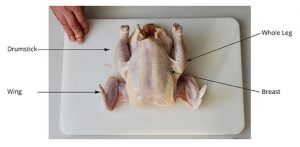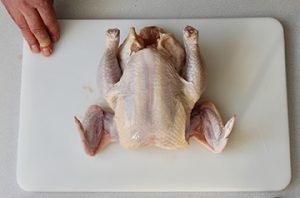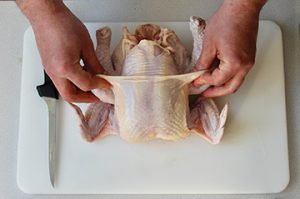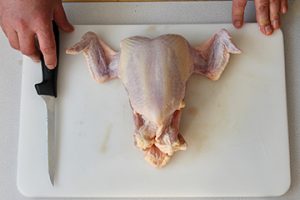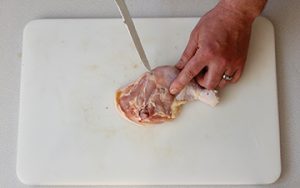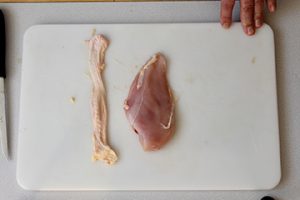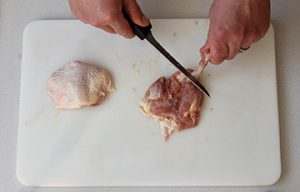Bulletin #4068, How to Cut Up a Whole Chicken
Bulletin #4068, How to Cut Up a Whole Chicken (PDF)
By Extension Professor Kate Yerxa, MS, RD, University of Maine Cooperative Extension
Rob Dumas, CEC, Food Science Innovation Coordinator and Facility Manager, University of Maine
Alex Gayton, MS, RD, Nutrition Professional, University of Maine Cooperative Extension
For information about UMaine Extension programs and resources, visit extension.umaine.edu.
Find more of our publications and books at extension.umaine.edu/publications/.
Chicken is a protein that can be eaten alone or as a part of many different recipes. Chicken pieces can be expensive to purchase, and it takes planning and time to cook a whole chicken. Look at the unit price information found on the chicken packages to compare the price difference between whole chicken and chicken parts. Cutting up a whole raw chicken by yourself can stretch your food dollars and help with meal planning and preparation. By following the steps outlined below, you will be able to enjoy fresh chicken while saving time and money.
Preparation
Start with a clean cutting board that has a clean damp towel or paper towel underneath to stop the cutting board from sliding on your counter. Use a clean, sharp knife to cut the chicken. In the photos below, a 6-inch boning knife is used to cut the chicken. If you don’t have a boning knife, use a sharp paring knife, or fillet knife to cut the chicken. Before handling any food, wash your hands with hot, soapy water for 20 seconds, rinse well and dry them with a clean towel.
Steps to Cut Up a Chicken
Step 1
Open the chicken package, discard any liquids and packaging. In some chickens, you will find a bag of giblets which typically contains the neck, liver, and gizzard. The giblets can be cooked and used in a variety of different recipes. Do not wash the raw chicken because doing so can spread bacteria in your kitchen.
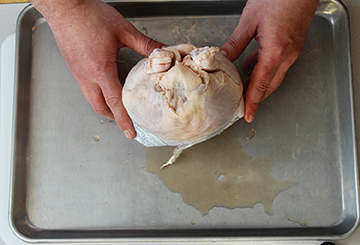

Place chicken on a clean, secure cutting board with breast side up and legs towards you.
Step 2
Loosen the skin between the leg quarters and body. Do this by massaging the skin with your fingers.
Cut through the skin between the thigh and body.
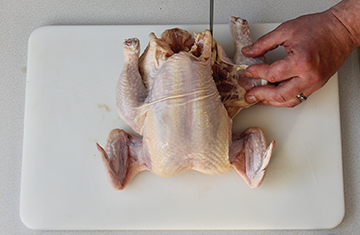
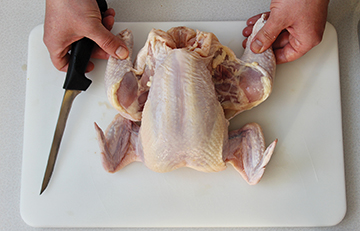
Bend thigh back until the hip joint dislocates.
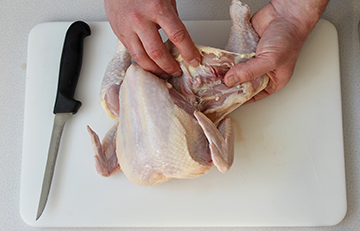
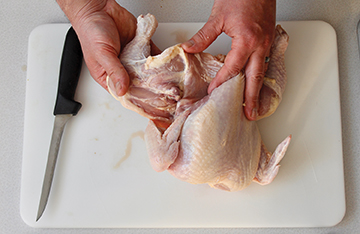
Cut through the joint, separating the leg from the body.
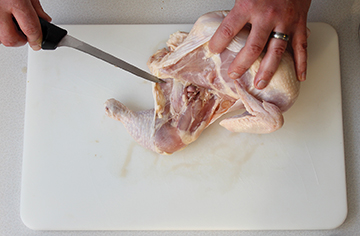

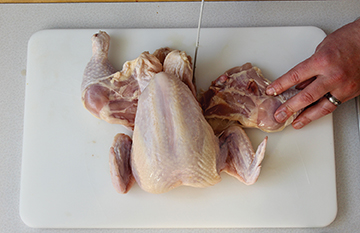

After removing the legs, place the chicken breast side up on the cutting board.
Step 3
Cut along down the middle of the breasts to expose the keel bone.

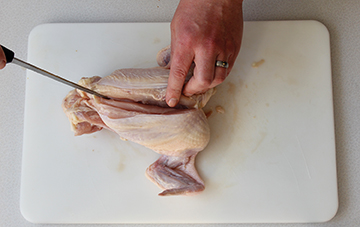
Start on one side of the keel bone and follow the curve of the ribs to remove the breast meat from the body.
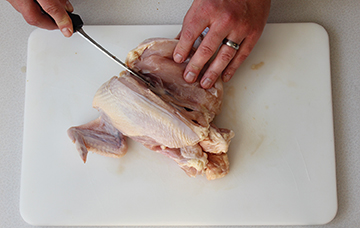
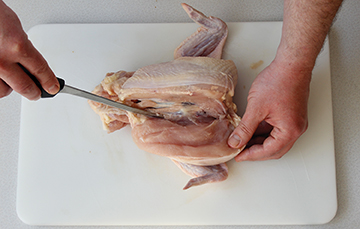
Pass through the wing joint where the tenderloin tendon connects to the body. Repeat on the other side.
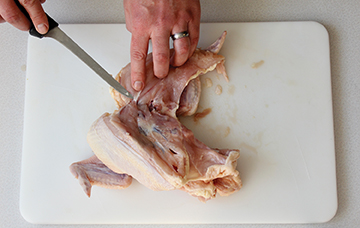
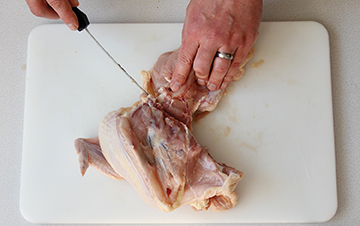

Once the breasts have been removed from both sides, the remaining carcass can be used for making stock or broth.

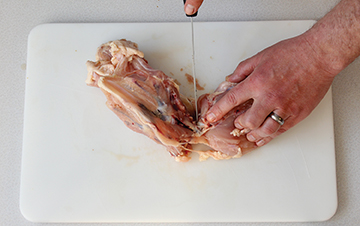


Step 4
To separate the thigh and drumstick place skin side down on the cutting board. Look for the line of fat between the leg and thigh.
Slice along the line of fat and cut through the join to separate. Repeat on the other leg.
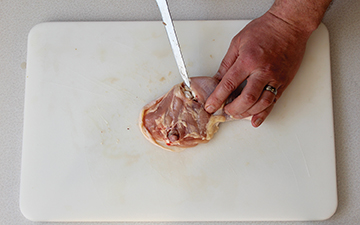
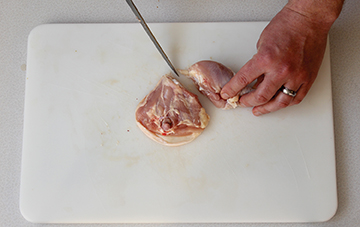
Step 5
To remove a wing, cut it away from the breast.
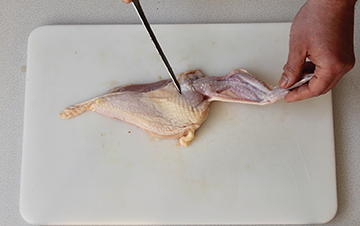
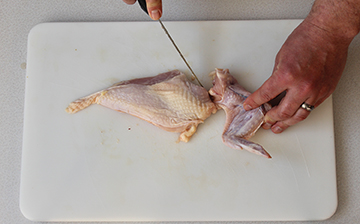
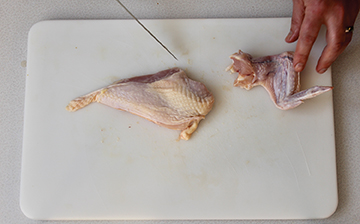

To remove the tenderloin, place the chicken breast skin side down and peel the tenderloin away from the breast.
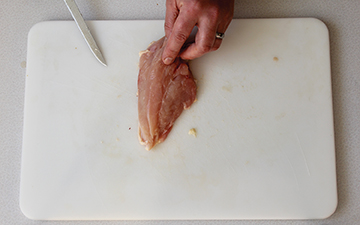
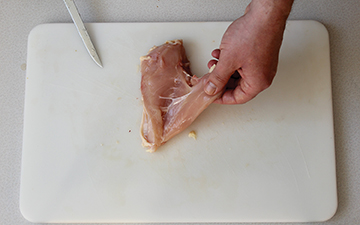
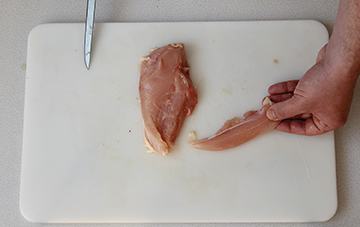
Step 6 – Optional
To remove the skin from the chicken pieces, hold the skin in one hand and firmly hold the chicken breast or thigh in the other. Then pull the skin off in one piece.
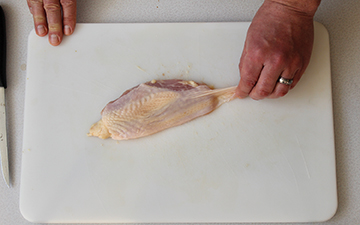
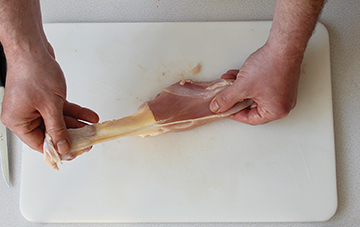
To remove the skin from the drumstick, hold the drumstick at the end with the most meat, and pull the skin toward the opposite end with your other hand.
Step 7 – Optional Boneless Thighs
To remove the bone from the thigh, place the chicken piece skin side down, and cut through the meat along the bone.
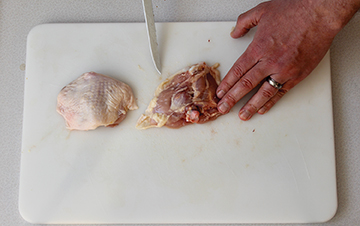

Fully expose the bone and insert a knife under the bone to free the joint at one end.
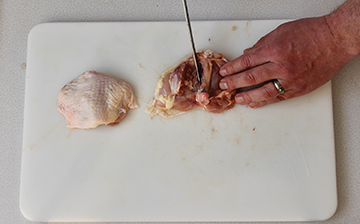
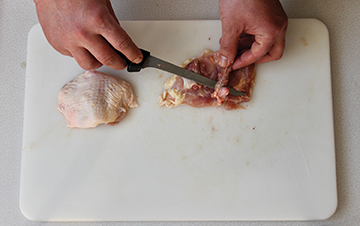
Hold the bone in your free hand and use the knife to scrape down the bone, releasing the meat.
Cut the thigh away from the bone to release.
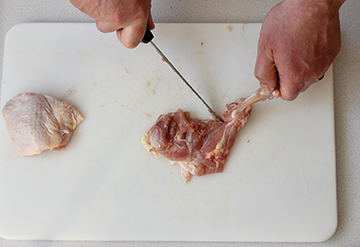
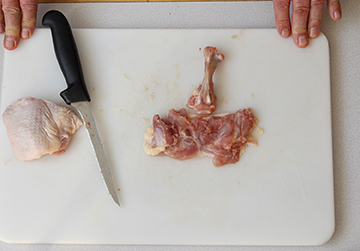
Cooking Skills How-To: How to Cut Up a Whole Chicken Video
Clean-Up
After cutting raw chicken, be sure to wash and sanitize your knives and cutting board. Wash with warm, soapy water, rinse, and then sanitize. You may clean your plastic or glass cutting boards in the dishwasher or sanitize by following these steps:
- Mix a scant teaspoon of liquid chlorine bleach to a quart of water.
- Pour the bleach mixture over the cutting board and keep wet for 2 minutes.
- Rinse with water and let the cutting board air dry.
Storing
If not using immediately, package the freshly cut chicken using heavy duty foil, plastic wrap, or freezer grade resealable plastic bags that keeps oxygen out to preserve the quality.
- Be sure to press any additional air out of the package before sealing.
- Package your chicken in the portion sizes you will use rather than all together.
- Store your packaged chicken in the coldest and lowest part of the refrigerator (if it will be eaten in 1-2 days) or freezer (if saving for later use) to avoid raw juices from leaking on other foods.
| Refrigerator Storage (40˚F) | Freezer Storage (0˚F) | |
|---|---|---|
| Fresh Chicken Pieces | 1-2 days | 9 months |
Source: Foodsafety.gov. FoodKeeper App.
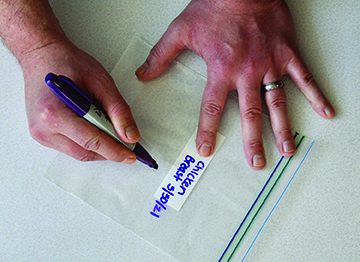
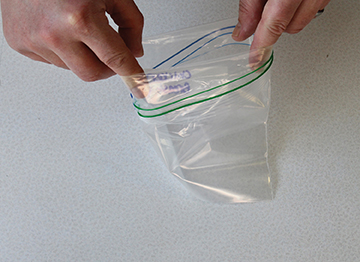
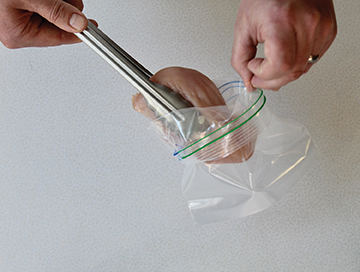

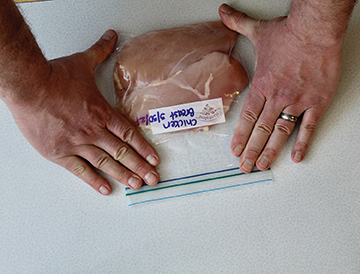
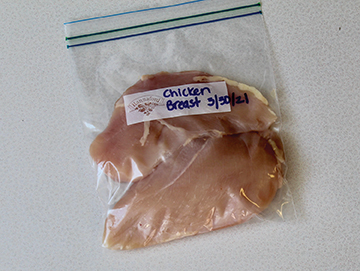
Thawing
When you are ready to cook the chicken, thaw the amount you plan to use ahead of time in the refrigerator. Or if you are planning to cook the chicken immediately, use running, cold water or defrost the frozen chicken in the microwave using the defrost/thaw setting.
- Do not thaw poultry at room temperature.
- If thawing in cold water, leave the chicken in the tightly closed packaging so water does not leak in. Change the cold water every 30 minutes. Once thawed, clean and sanitize the sink and dish used to thaw the chicken.
- If thawing in the microwave, follow the manufacturer’s directions and cook the chicken immediately after it has been defrosted.
Cooking
Marinating chicken adds flavor to your meal and should be done in the refrigerator and not at room temperature. The leftover marinade should be thrown away and not reused or added to cooked foods.
Poultry should be cooked to an internal temperature of at least 165˚F. Using a food thermometer inserted into the thickest part of the chicken is the only reliable way to determine if your chicken is cooked appropriately and will reduce the risk of foodborne illness. Leftover cooked poultry may be stored in the refrigerator or freezer for later use following the guidelines below.
| Refrigerator Storage (40˚F) | Freezer Storage (0˚F) | |
|---|---|---|
| Cooked Poultry Dishes | 3-4 days | 4 months |
Source: Foodsafety.gov. FoodKeeper App.
Information in this publication is provided purely for educational purposes. No responsibility is assumed for any problems associated with the use of products or services mentioned. No endorsement of products or companies is intended, nor is criticism of unnamed products or companies implied.
© 2021
Call 800.287.0274 (in Maine), or 207.581.3188, for information on publications and program offerings from University of Maine Cooperative Extension, or visit extension.umaine.edu.
In complying with the letter and spirit of applicable laws and pursuing its own goals of diversity, the University of Maine System does not discriminate on the grounds of race, color, religion, sex, sexual orientation, transgender status, gender, gender identity or expression, ethnicity, national origin, citizenship status, familial status, ancestry, age, disability physical or mental, genetic information, or veterans or military status in employment, education, and all other programs and activities. The University provides reasonable accommodations to qualified individuals with disabilities upon request. The following person has been designated to handle inquiries regarding non-discrimination policies: Director of Equal Opportunity and Title IX Services, 5713 Chadbourne Hall, Room 412, University of Maine, Orono, ME 04469-5713, 207.581.1226, TTY 711 (Maine Relay System).


